
Red fish like salmon, trout, and sockeye are more than just tasty — they’re nutritional powerhouses rich in omega-3s, high-quality protein, and essential vitamins. Including them in your diet a few times per week can deeply support your skin, digestion, metabolism, and more.
✅ Why Red Fish Is So Beneficial
1. Omega-3s for Brain, Skin & Heart
Red fish are one of the best sources of EPA and DHA omega-3 fatty acids, which:
- Reduce inflammation
- Improve brain function
- Support skin hydration and elasticity
- Lower risk of heart disease
If you’re looking for how to improve skin health and nourish your body at a cellular level, red fish is a smart choice.
2. High-Quality Protein
A single serving provides around 20–25g of easily digestible protein that:
- Supports muscle maintenance
- Keeps you full for longer
- Stabilizes blood sugar levels
Ideal for anyone aiming to lose weight quickly and safely while preserving lean body mass.
3. Gut-Supporting Nutrients
Red fish contains vitamin D, selenium, and B vitamins that:
- Support a healthy intestinal lining
- Improve immune response
- Feed beneficial gut flora indirectly
It’s a gentle, delicious step toward improving gut health naturally.
4. Vitamin D and B12 Boosts Energy and Mood
Many people are deficient in vitamin D and B12 — red fish offers both in abundance, which helps:
- Reduce fatigue
- Improve mood and focus
- Enhance metabolic health
Perfect if you’re working on improving overall health and daily energy levels.
⚠️ What to Watch Out For
While red fish is generally very healthy, consider the following:
- Mercury risk is very low in wild salmon or trout, but still worth moderating intake (2–3x/week is ideal)
- Farmed fish may contain more saturated fat and contaminants, so choose wild-caught if possible
- Portion control matters — avoid drenching fish in heavy sauces or frying
🧠 How to Eat Red Fish the Healthy Way
1. Best Cooking Methods
- Steamed, baked, grilled, or pan-seared
- Avoid deep-frying or overly processed options
2. Best Pairings
- With lemon, olive oil, and herbs
- Alongside vegetables, quinoa, or whole grains
- With fermented foods (like kimchi or sauerkraut) to support gut health
3. Ideal Portions
- 100–150g (3–5 oz) per meal
- 2–3 servings per week for optimal benefits
💡 Tips for Maximum Benefits
- Choose wild-caught over farmed
- Store properly (freezing is fine!)
- Combine with sources of antioxidants (leafy greens, berries) for synergy
- Add fish oil only if you don’t consume fish often
📌 Conclusion
If you’re focused on how to improve your skin, heal your gut, lose weight safely, or simply enhance your overall health, red fish is a natural, flavorful ally. Eating it a few times per week is one of the simplest ways to nourish your body from within — and enjoy every bite.